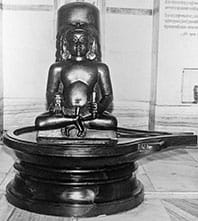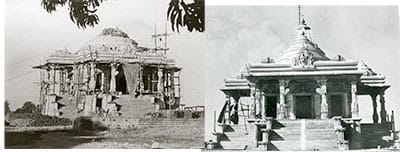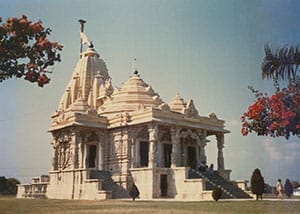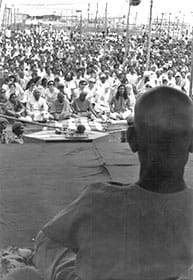[breadcrumb]
Kayavarohan – Kripalu’s Mission
 In December 1955, the villagers of Kayavarohan invited Kripalu to come and lecture. Bapuji tells the remarkable story:
In December 1955, the villagers of Kayavarohan invited Kripalu to come and lecture. Bapuji tells the remarkable story:
I accepted their invitation and then regretted it as I had made the decision in haste, but I still decided to go. Although the village was only 25 kilometers from my native town of Dabhoi, I had never been there. Furthermore, I didn’t know that Kayavarohan was one of India’s ancient and important holy places.
On the third and final day of my talks, the leaders of the village approached me and said,
“Swamiji, Kayavarohan is a great and ancient tirtha (sacred pilgrimage place). It’s considered to be as holy as Kashi. If you wish, we would like to show you some temples and ancient idols. We’ll also acquaint you with the history of the place.”
 I accepted their invitation and spent about two hours visiting various temples in the area. Finally we arrived at the temple of Brahmeshwar Mahadev. In that temple I saw the jyotirlingam with an idol carved in its front. My eyes were drawn like a magnet to this holy idol. In an instant flash of transcendental insight I knew the full and divine truth depicted in the idol.
I accepted their invitation and spent about two hours visiting various temples in the area. Finally we arrived at the temple of Brahmeshwar Mahadev. In that temple I saw the jyotirlingam with an idol carved in its front. My eyes were drawn like a magnet to this holy idol. In an instant flash of transcendental insight I knew the full and divine truth depicted in the idol.
The idol carved into the front of the jyotirlingam was the exact same form as the divine form of my Gurudev! I had seen this very form at Rishikesh, as well as at Rajpipla. At the same time, I also knew that the form on the front side of the jyotirlingam was ages old. Then I remembered Gurudev’s words.
“My son. It’s only through divine fortune that you’ve seen this real body of mine, and in a similar manner you’ll come to know my real name at a later time.”
And, indeed, this is how it happened.
Thus, I learned that the true name of my beloved Gurudev was Lord Lalulish, the 28th incarnation of Lord Shiva, an ageless being ever reveling in the most sublime and elevated state of yoga. I also remembered something else he had told me.
“I can tell you that this body of mine is many, many years old. It has an interesting history that you will have to investigate in the future.”
Tears flowed down my cheeks. I felt like I would faint or collapse. My legs wobbled so I leaned on the adjoining wall for support. Slowly I regained my composure and prostrated before the jyotirlingam, my heart full of gratitude that destiny had been so merciful to me. Perfect bliss and divine peace ran through my mind. Here, in this small temple, I felt that my life was fulfilled.
Before leaving the temple, I took another close, long look at the idol of Lord Lakulish. This time my eyes roamed over all the parts of the holy idol until I had captured its divine beauty to my heart’s content. I found no difference between this enchanting idol and the divine form of my Gurudev. It revealed the short build, the bewitching and charming face, and those eyes filled with abounding mercy that I had seen in Gurudev’s living form in the hills of Rishikesh. With heartfelt devotion I prayed,
“Oh kind and merciful Gurudev! I’m purified by the darshan you’ve granted me. I humbly desire to stay at your pious feet in this holy place. Kindly give me your command if I can be of any service to you. I’ll carry it out to the best of my ability.”
That evening I sat in meditation while remaining in Kayavarohan. My mind plunged into deep concentration. I then mastered a difficult stage of yoga for which I had long been striving.
 During my meditation I had divine visions of Kayavarohan in the days of the great sage Vishvamitra, when it was called Medhavati, and also in its new and sparkling beauty in the times of Lord Lakulish. In this blissful meditation, Lord Lakulish and Maharshi Vishvamitraji appeared and gave me this divine command:
During my meditation I had divine visions of Kayavarohan in the days of the great sage Vishvamitra, when it was called Medhavati, and also in its new and sparkling beauty in the times of Lord Lakulish. In this blissful meditation, Lord Lakulish and Maharshi Vishvamitraji appeared and gave me this divine command:
“My son, we have chosen you to lead the revival of Kayavarohan as a holy pilgrim center and also the revival of spiritual culture.”
“My Lord,” I responded, understanding the Herculean task of reviving Kayavarohan, “Your grace has made my life sublime. I accept your holy command respectfully, but I fear it’s beyond my reach to fulfill such a gigantic task. However, I will gladly act as your humble servant.”
“Don’t worry,” the Divine Beings said. “You only have to be the dedicated instrument. The divine plan will take care of itself.”
They then disappeared.
I remained lost in divine bliss, filled with joy and wonder. In this transcendental state, a prayer came to me
“I worship the Divine Light.
I worship all that is Holy, forever and beyond.
In infinite bliss and infinite grace,
I worship the light transmitted from guru to disciple.
I worship the Divine Light
That is God within all and everything.”
The History of Kayavarohan
The village of Kayavarohan, which today is popularly known as “Karvan,” located in Vadodhara district, has been a great and famous place of pilgrimage in all the four eras. It is also a very ancient place. This pilgrimage place was known as Icchhapuri in Satya Yoga (Golden Era), as Mayapuri in the Treta Age, as Medhavati in the Dwapara Age, and as Kayavarohan in the Kali Age.
During the age of Lord Rama’s incarnation, the great sage Vishvamitra had resolved to elevate this place to a status parallel to that of Kashi, which traditionally has the reputation as a place for attaining liberation. But a vociferous opposition from the devas prevented this from being accomplished. Even so, Kayavarohan of that day and age was second only to Kashi in its reputation as a sacred place.
It was at that time a famous place of pilgrimage and went by the name of Medhavati. Sage Vishvamitra was a sagacious seer of Gayatri Mantra, which is propitiated for the purpose of purifying one’s intellect. One of the synonyms for intellect (Buddhi) is Medha. Thus it is that the sage called his own (spiritual) sanctuary by the name Medhavati.
It was right from here that canonization (sanctification) of the Gayatri Mantra first started and spread outwards. This great place of pilgrimage is thus an important relic of the culminating glory of Brahmanic culture. In the waning years of the Dwapara Age, during the incarnation of Lord Krishna, Lord Lakulish first manifested here. Since that time, this place came to be known as Kayavarohan, implying thereby that Lord Shiva himself descended into a human body (kaya).
The Temple is Re-inaugurated
 On March 5, 1974, the temple was finished on schedule according to Dadaji’s command. Twenty thousand people gathered for the dedication service. Before the ceremony, Kripalu entered the beautiful temple alone to pray and wrote of his experience:
On March 5, 1974, the temple was finished on schedule according to Dadaji’s command. Twenty thousand people gathered for the dedication service. Before the ceremony, Kripalu entered the beautiful temple alone to pray and wrote of his experience:
On the morning of the inauguration, I spent nearly an hour alone inside the new temple behind the closed doors. The inner sanctuary of the temple was equipped with a ghee lamp, incense, sandalwood paste, flowers and other sacred materials. A mattress was also placed there on which to sit and worship. Everything was arranged according to my instructions.
 I lit the ghee lamp and burned incense, filling the air with fragrance. Then I closed my eyes and with deep, heartfelt devotion, I invited Gurudev to appear. After some time I heard the spontaneous sound of Om Namah Shiva. I opened my eyes and saw a divine light spreading all around me in the temple. I looked up at the temple ceiling, which had an opening at the apex through which the idol of Lord Shiva was to be ritually lowered into the temple. I saw a glow of light descending through the opening. It was like a shining ball spreading the light inside the temple sanctuary. It moved downward and then remained steady in mid-air a few feet above the floor of the sanctuary. I became alert and stood up. Slowly the divine form of Lord Lakulish, my Gurudev, sitting in padmasan emerged from the light.
I lit the ghee lamp and burned incense, filling the air with fragrance. Then I closed my eyes and with deep, heartfelt devotion, I invited Gurudev to appear. After some time I heard the spontaneous sound of Om Namah Shiva. I opened my eyes and saw a divine light spreading all around me in the temple. I looked up at the temple ceiling, which had an opening at the apex through which the idol of Lord Shiva was to be ritually lowered into the temple. I saw a glow of light descending through the opening. It was like a shining ball spreading the light inside the temple sanctuary. It moved downward and then remained steady in mid-air a few feet above the floor of the sanctuary. I became alert and stood up. Slowly the divine form of Lord Lakulish, my Gurudev, sitting in padmasan emerged from the light.
I was overcome with joy when I saw Gurudev’s divine. Tears of rapture gushed from my eyes. Immediately I took some flowers from a nearby plate and showered them on Gurudev’s head. I worshipped him by performing ritual puja and prostrated before him. I then stood with folded hands before Gurudev and tried to speak but I couldn’t utter a single sound.
“Swami!” Gurudev said, breaking the silence. “I’ve come in response to your prayer. You’ve fulfilled the task I assigned to you. I’ve very pleased.”
At the sound of these sweet and encouraging words I was filled with great satisfaction and said calmly,
“Gurudev! I’m truly purified by your divine presence and darshan. It’s only with your blessings, and not by my endeavors, that this temple has been completed. Yet, if there’s anything missing, kindly forgive me.”
“Son! The temple is beautiful and I like it.”
“Soon we’ll install your idol on this spot. I pray to you to reside here in your divine form forever and thus bless us.”
“This holy place is mine and I will always remain here. My divine energy will enter into the idol in a very special subtle form after it has been ritually installed.”
“Lord! These assuring words will create limitless devotion among your followers. If there are any further instructions for us, we’ll surely carry them out. Pray tell me.”
“Yes! Notice the height at which my present form is suspended in the air. The lingam should be installed so that my idol sits exactly at this height.”
“Your instructions will be carried out.”
I carefully assessed the height at which Gurudev’s divine form was floating.
“Swami! You’ve finished one task, but now resume immediately the other task I have entrusted to you, that of cultural revival.”
“Gurudev! That’s a very complex task. Until I master samadhi I don’t think I’ll be able to fulfill this task. If I begin this project before mastering samadhi, I may encounter many obstacles to my spiritual progress. So first, I intend to go to some secluded place away from people and achieve my final spiritual goal. If I have your kind permission to stay with you in the Himalayas, I’ll be able to finish my spiritual journey quite quickly. Then I’ll take up the second task.”
“You still have physical limitations, so you won’t be able to survive in the desolate Himalayas. Until you attain freedom from physical factors like cold, heat, hunger and thirst you can’t avoid public contact.”
“Then kindly please bless me to be a sthitaprajnya (one with perfect equanimity) so that I can still live amidst people and take up the task of cultural revival without any disturbance to my yogic pursuits.”
“To become a sthitaprajnya you must strive on your own. Make purusharth (effort)—be a man of duty and action, and also meditate.”
“I would first like to go to some faraway place like Haridwar or Rishikesh and live in isolation. I think this will facilitate my sadhana. Here I find that I get involved with many activities that create numerous obstacles to my sadhana.”
“Swami! You can become a sthitaprajnya while living here and not by running away. The latter course won’t benefit you.”
“Then kindly tell me how many years do I have yet to struggle to attain my yogic goal?”
“That depends on the intensity of your sadhana. I can’t say for certain.”
“Gurudev! You’re omniscient. How can there be anything unknown to you! This is all I want to know. Otherwise, my patience may run out.”
“You still have to strive for one-quarter more of your yogic pursuit to achieve your goal.”(about 8 more years)
“Oh Lord! Is twenty-four years of yogic effort so inadequate that I still have to struggle so much more?”
When I said this, I burst into tears and placed my head at Gurudev’s holy feet. Moments later, when I raised my head, Gurudev had disappeared.
I calmed down. There was no sorrow in my heart. It was filled with the joy and satisfaction of having had Gurudev’s darshan.
A few minutes later I opened the temple doors and walked outside. Then I signaled the dignitaries to follow me and we walked together to my residence. When everyone was seated I asked, “What is the height of the stone base that will support the idol?”
 Mr. Dahyabhai Patel, the man supervising the temple work, said, “Two feet.”
Mr. Dahyabhai Patel, the man supervising the temple work, said, “Two feet.”
“That’s a bit high,” I said calmly. “Adjust it so that the idol of Bhagwan Lakulish remains one and three quarters feet from ground level when the lingam is installed.”
‘Yes,” Dahyabhai replied, “That can easily be done since the circular stone isn’t yet fixed with cement.”
Thus the lingam was installed at the exact height that my Gurudev had requested.
Today Kayavarohan remains a popular pilgrimage site in homage to the Lakulish Lineage of Masters, and one of the 68 tirthas to Lord Shiva as foretold in the Shiva Purana.
